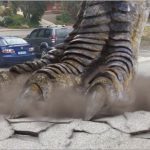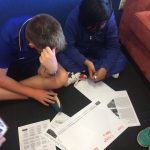 “Has ability but needs to apply himself” was a constant report comment throughout my school life. I really didn’t enjoy school very much, and certainly wasn’t considered a good student. Ironically, I am now in my 11th year as a teacher.
“Has ability but needs to apply himself” was a constant report comment throughout my school life. I really didn’t enjoy school very much, and certainly wasn’t considered a good student. Ironically, I am now in my 11th year as a teacher.
As a student I had trouble engaging with lessons when I couldn’t apply the learning to my life (I still have this problem!) I was also a bit of a handful when I didn’t ‘like’ my teachers. I was bored a fair amount of the time, and only found myself in more trouble when I questioned WHY we were learning certain things. Of course it wasn’t all bad, I loved HPE, Technology and the Arts, but I wasn’t really able to take much control of my learning until years 11 & 12. Like most people I had a few amazing teachers who inspired me (thanks Mr Blessing/Mr Flanagan), but many of my teachers seemed as uninterested in my education as I was.
So when I began my career, I knew exactly what kind of teacher I didn’t want to be.
I still ask myself regularly whether I would be happy to be a student in my own classroom. Most of the time the answer is yes. But, there is still a big disconnect between what I do, and what I think a truly amazing classroom could be. This is the divide I am trying to close with our “City of Glacier Park” project.
I think most of my students are engaged most of the time, and I work hard to individualise programs where I can. I’ve certainly become much better at differentiating learning for wide variety of ability levels. Over the past few years I’ve worked with some students with significant learning challenges, who have forced me to change the way I approach many learning tasks in order to find different entry and exit points that allow ALL students to achieve success. What I’ve also noticed in recent years is that students who were struggling with more traditional, structured learning, were far more engaged, enthusiastic, and actually at school more often when we used Project Based Learning (PBL) tasks.
At various times in the past we have ‘suspended classes’ to tackle big PBL tasks. We collaborated to write and publish e-Books for younger students, families and friends to download from the Apple i-Books store. We organised younger classes to read our books and vote for their favourite during a book week competitions. We Skyped structural engineers in Canada to get tips on how to build pop-stick bridges which we tested to destruction in front of classes of excited peers.
The point is, when we REALLY engaged with the world outside of our 4 classroom walls, the kids did better. So the question became “If I can do this some of the time, how can I find a way to do it all of the time?” The more authentic and connected to the real world a task is, the more willing kids are to persevere and more likely they are to succeed.
A Dan Haesler training and development day a couple of years ago planted a seed that has been propagating ever since. Some of Dan’s key points on the day were:
- The need to establish trusting, caring and respectful relationships so learning can occur. Children won’t engage if they think a teacher doesn’t like or care about them (hmmm, sounds familiar…)
- Engagement is not to be confused with compliance and conformity. Students need to engage in their life, their world around them, and the future.
- Learning tasks must have a purpose – community projects, blogs, video show-and-tell explanations etc.
- Students need some autonomy in learning experiences.
- Generation Z learners are used to using up to 5 screens, communicate with images, want to create things, are future focused, and want to work for success.
- Technology is a tool best used to raise awareness, to find answers, to take action, and to start conversations.
“Great” I thought upon leaving. I do all of that stuff.
But upon reflection, when I honestly dug down into each point, I realised I was coming up short. I was on the right track, but I was far from a poster boy for 21st century learning. Particularly when it came to ‘real’ and ‘authentic’ learning experiences and student autonomy.
So I’ve been kicking this idea around for some time. Lurking on Twitter, stealing ideas from educators all over the globe, but ultimately searching for one big idea to tie it all together. Anthony Johnson’s “Johnsonville” classroom in North Carolina was that idea. I’m not sure I can do a summary of his program justice, so I’ll just include some links to articles that explain his methodology far better than I can.
So after 11 weeks of discussing, planning, designing, voting and creating with my class, we are ready to launch our city. We are using 4 C’s to guide our journey: Critical Thinking ; Creativity; Collaboration and Community.
Why now? We have an amazing learning space made up of 3 separate learning areas, access to 1:1 iPads and Chromebooks for part of each day, a supportive principal and a ticking clock. As a contract teacher, who knows when/if I will ever have this kind of chance again to revolutionise my teaching and my students learning.
There are still lots of obstacles to overcome. Making learning truly authentic when attempting PBL tasks is a work in progress. Finding practical ways to consistently assess outcomes when I might get 25 different examples of work has been a challenge. Linking to the Australian Curriculum and staying true to the spirit of learning outcomes without getting bogged down in content is also an area of ongoing work.
I have to be the change I want to see, so I have committed to doing some tasks that I find challenging. I’m aiming to share more with my community and leading by example amongst my peers. I’m going to try and engage parents and families through better communication and opportunities to be more involved in our learning. I’m committed to reaching out and making real connections with people who can and are willing to contribute to our learning. Most importantly, I’m handing the keys to the classroom and their learning over to my students, and we are going to have a genuine attempt at creating our perfect classroom.
We aren’t diving in the deep end to start, we will be wading around in the paddle pool for a while until we get a better understanding of what works and what doesn’t, then we will be heading for the 5m diving board!
Abe Moore
Year 6/7 Teacher
Hallett Cove South Primary School
Adelaide, South Australia






